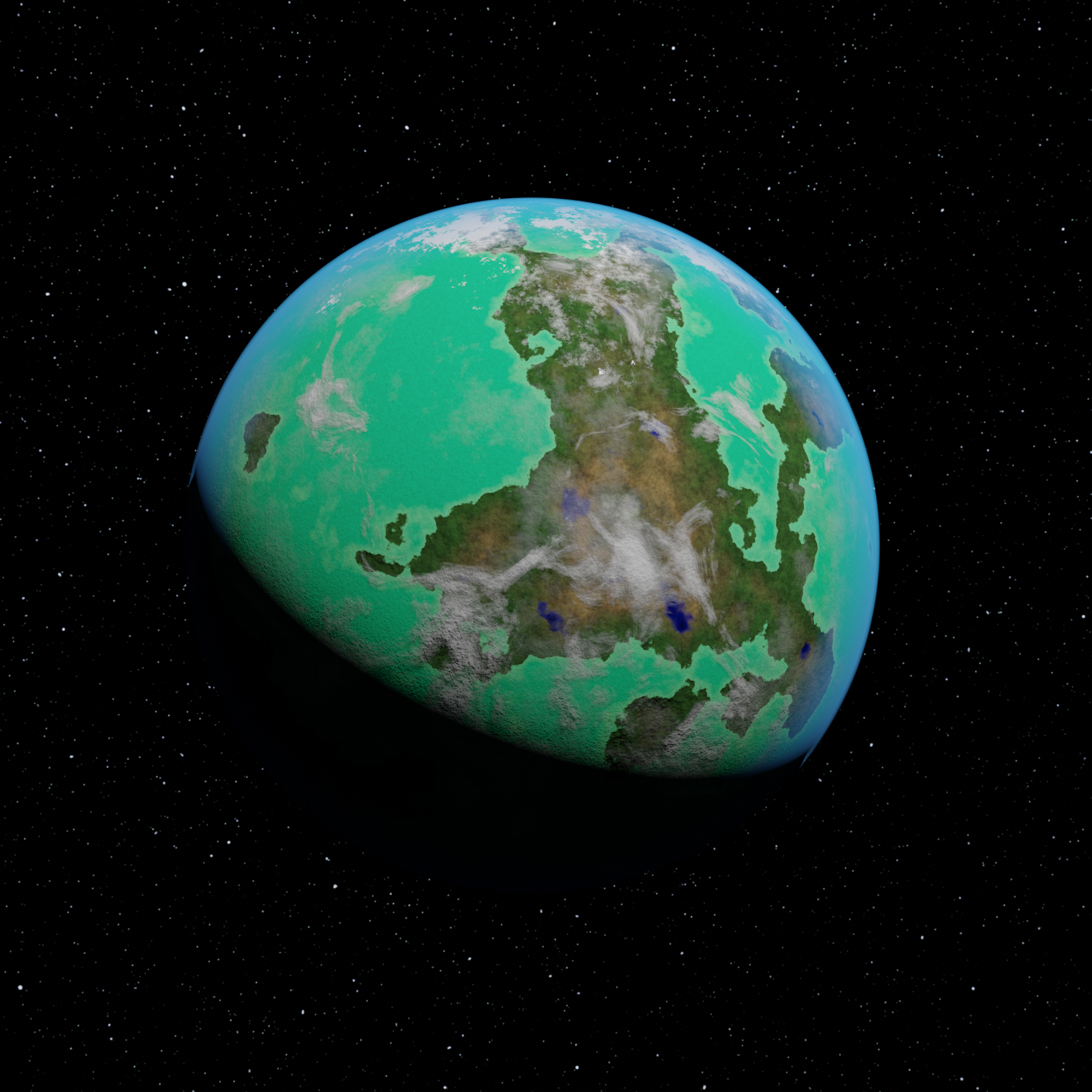Callis 2
Callis 2 is an earthlike planet, with one notable difference: The ocean of the planet is a bright sea-green colour, from chemical compounds found within the water. These compounds are acidic and corrosive, eating through flesh in seconds.
The ocean’s toxicity began some time within the last hundred thousand years, when an asteroid carrying the chemical mixture collided with the planets ocean. This caused a mass extinction of the planet’s marine life, which were ill-suited to life in the new conditions.
The planet’s freshwater, however, is able to sustain humanoid life. When water evaporates from the ocean, it leaves behind the toxic chemical, and enters back into the water cycle, giving the planet a fresh glacial supply at its high points, which filters into rivers and lakes.
Geography
The planet features a single supercontinent, as well as a few small surrounding islands. The contient is mostly in the northern hemisphere of the planet, but the southern side of it passes the equator, but remains in the tropics. The continent has a varied landscape, featuring mountains, plains, and borealesque forests.
Much of the planet remains unsettled, leaving pristine landscapes that are rich with the planet’s native organisms.
Ecosystem
There have been changes to the ecosystem since the introduction of humanoid life to the environment. Studies concluded that damage to the planet’s biodiversity would be insignificant with colonization, though anti-colonial activists argue that any loss of unique life is a tragedy. Pet cats and dogs have caused some dinosaur-bird species to decline, though none have been driven to extinction.
Localized Phenomena
Hurricanes on Callis 2 are dangerous and severe, which has led colonists to avoid settling near the coast. Toxic water from the ocean gets up onto the land and destroys all life in its path. Weather closer to the center of the supercontinent tends to be milder, though in the plains, tornados have been known to occur.
Climate
The climate of the planet is mild, on the cool-end. Mountainous regions reach temperatures below freezing that are unheard of on earth. Few travel into these regions as they are quite inhospitable, and do not support many living organisms.
Fauna & Flora
Life evolved on Callis 2 prior to the chemical toxicity of the planet’s oceans. Plants on the planet are much like Earth, though more limited. Boreal-esque trees that do not shed their leaves and needles in the colder months cover much of the planet.
The only vertebrate wildlife that has been able to sustain itself following the mass extinction caused by the chemical-baring asteroid are birdlike creatures, somewhere between what we think of as birds and dinosaurs. They were the dominant species of the ecosystem before the arrival of human life. Also extant on the planet are several thousand species of small invertebrates, which consist the main diet of the bird-creatures.
The only known remaining inhabitants of the ocean are phytoplankton and one species of shrimp-like invertebrate that resides in underwater volcanos— these have only been observed once by a scientific expedition intending to discover whether or not any life remained in the now toxic ocean.
Natural Resources
The most notable resource on the planet are raw elements that can be used in the manufacturing of the various systems of sentient androids. In the time since humanity began exploring the stars, a search for natural deposits of a resource called Vitarium has been conducted on many planets. It is a compound that is said to be able to “conduct electronic lifeforce”, making it vital to the inner workings of sentient androids. Vitarium deposits were discovered in a cold desert on the south east of the continent around a hundred years ago, where industry sprung up as soon as the planet was colonized.
Though not a natural resource itself, it is worth mentioning that the main industry of the planet is factory work. The largest factory on the planet is that of Atomo Dynamics, where many of their low-end service androids are produced. The factory sprung up as a strategic placement for its proximity to the Vitarium used in the manufacturing of the androids. Since the Atomo factory expanded and succeeded financially, many other factories have sprung up in surrounding areas on the planet.
Another natural resource of the planet is wood. It is not as significant as the Vitarium as wood can be sourced from many planets, but there is a prevalent logging industry on Callis 2 as well.
History
The planet was first discovered on an exploratory mission in the -300s. Hundreds of years later, upon a re-examining scan, it was discovered that the planet hosted rich deposits of Vitarium. In the decades following this discovery, colonists prepared for and began to settle the planet.
It took a few more decades before Atomo Dynamics decided to build their factory on the planet. Following the construction, all industry has grown on the planet. Vitarium continues to be mined today, as the factories which buy the material operate.
Tourism
Callis 2 does not have an extensive tourism industry. Its only amenities for such are focused around those who already live on the planet taking short vacations from their homes, and accommodating business travellers who come for meetings with company executives and factory inspections.



Acid Oceans are one of my nightmares! Great article. Thanks for sharing!
Haly, the Moonlight Bard
Television Sky , an all-human independent punk media publishing house.
Just saw your comment-- Thanks so much! I thought the contrast of having fresh water on a planet where the oceans are toxic was a fun concept :)